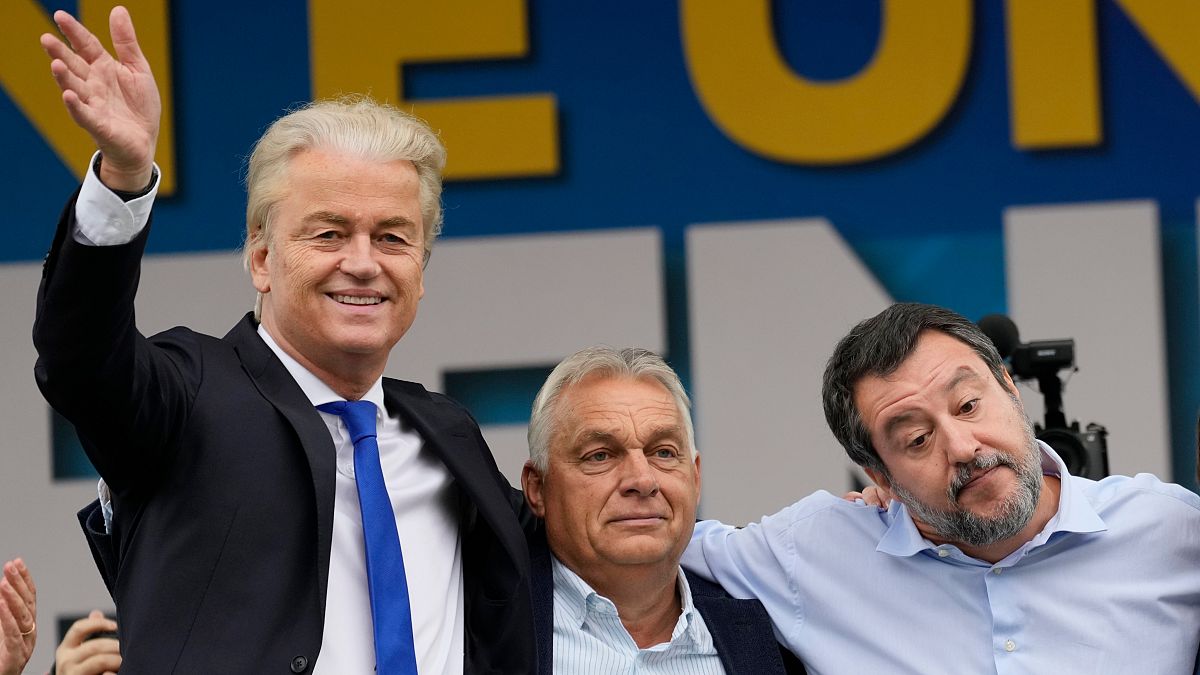The three most right-wing groups of the European Parliament and their members are all known as ‘far-right’ — but they have some crucial differences.
The members of Patriots for Europe met in Brussels for the first time on Thursday, convening on the sidelines of the European summit.
The group is one of three at the right-wing end of the European Parliament, joined by Europe of Sovereign Nations (ESN) and the European Conservatives and Reformists (ECR).
The parties making up these three parliamentary groups are generally nationalist, sovereigntist, conservative and Eurosceptic, thoguh their positions differ on Russia and Ukraine and on their precise relationship to the European Union.
But while they can all be classified as far-right in one way or another, most of them reject this label.
Extreme right, hard right, radical right, national conservative, populist: these terms have invaded European public debate, and the lines between them are becoming increasingly blurry. So where do the differences really lie?
Euronews spoke to an expert about how to classify them.
Extremist, illiberal and nativist
“The Europe of Sovereign Nations is the most extreme far-right group in the European Parliament,” says Dave Sinardet, Professor of Political Science at the Free Flemish University of Brussels.
Created in July, it is now the newest and smallest parliamentary group, and the notorious Alternative for Germany accounts for more than half of the group’s 25 members. Also on board are a Polish party, Confederation, and Bulgarian MEPs from the pro-Russian party Renaissance.
Sinardet says a number of these parties can justifiably be described as extremist.
“This means that they do not always respect parliamentary democracy and that they have a number of authoritarian traits,” he explained.
The professor also describes the group as illiberal, because it has problems accepting the independence of the judiciary, the rule of law and individual freedoms, and nativist, because of its opposition to immigration and the distinctions it draws between immigrants and native-born citizens.
“The parties that are clearly illiberal and nativist are to be found mainly in the Europe of Sovereign Nations,” says Sinardet. “Some parties that are part of the Patriots for Europe can also be considered illiberal”.
Populism, not demagogy
With 86 MEPs, the Patriots for Europe is the third largest force in the European Parliament.
Created in July, its members make up a who’s who of European right-wingers: from France, Marine Le Pen’s Rassemblement National; from Hungary, Viktor Orbán’s Fidesz; from Italy, Matteo Salvini’s League; from Spain, Santiago Abascal’s Vox party; and from Austria, Herbert Kickl’s FPÖ.
Patriots for Europe and Europe of Sovereign Nations can also be classified as populist, according to the professor.
Often confused with demagogy, populism refers to a binary vision of society that pits an elite presented as corrupt against “the people”, who are presented as homogeneous and pure.
Populism can be left- or right-wing. The strongly left-wing La France Insoumise, for example, is also widely considered a populist party.
Recipe for radicalism
Finally, some parties of the European Conservatives and Reformists (ECR) are often described not as far-right or extreme, but “radical right”.
With 78 MEPs, this group is mainly built around Italian Prime Minister Giorgia Meloni’s party, Brothers of Italy, and former Polish leader Jarosław Kaczyński’s Law and Justice.
According to political scientist Cas Mudde, the term radical right refers to parties that combine two ideologies: nativism and authoritarianism, which together consider adherence to authority a supreme value.
“Not all European conservative and reformist parties can be considered radical right-wing,” adds Sinardet. “They are often rather nationalist and conservative. But others can be considered radical right-wing”.

